The Big Sky state is enormous, with a massive variation in landscape, from jagged peaks to flat prairies. It isn’t the most hospitable environment for some birds, with brutal winters and hot summers. But even still, at least ten woodpeckers made Montana their home for at least part of the year.
Between Glacier National Park, Yellowstone National Park, and Flathead Lake State Park, there are vast riches of areas for birdwatchers to spot their favorite species or complete their Life List. If you’re willing to put on your hiking boots and bring some binoculars, you can likely see several species in a single day.
But even those who want to take it easy while spotting woodpeckers can identify several species in their own Montana backyards.
Whether you’re hiking in a stunning wilderness area or taking in the sights in Helena, there’s probably at least one species of woodpecker nearby.
Here is the list of species of woodpeckers in Montana:
- Downy Woodpecker
- Hairy Woodpecker
- Lewis’s Woodpecker
- Red-Headed Woodpecker
- Red-Naped Sapsucker
- Northern Flicker
- American Three-Toed Woodpecker
- Black-Backed Woodpecker
- Pileated Woodpecker
- Williamson’s Sapsucker
10 Types of Woodpeckers in Montana
1. Downy Woodpecker
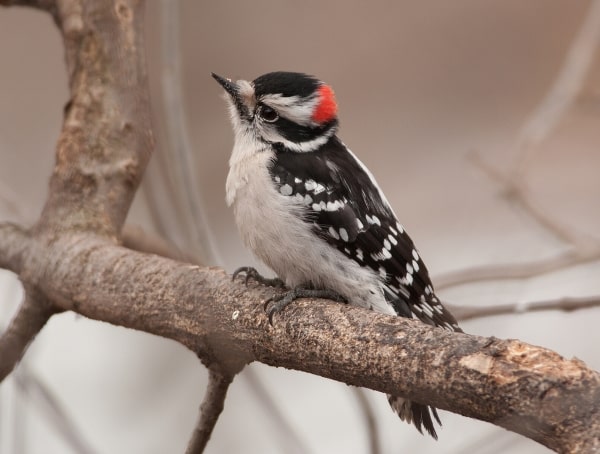
Scientific name: Dryobates pubescens
Size: 7 inches long
Weight: 0.75-0.99 ounces
Wingspan: 10-12 inches
The downy woodpecker is the smallest woodpecker in Montana, but its tiny size doesn’t make it difficult to spot. That’s because it’s bold and not too afraid of people. It’s probably the most common woodpecker to see in all of Montana, so the chances are good that you’ll be able to see one.
This cute little bird doesn’t migrate. Instead, it stays in its home year-round, which means you can spot these woodpeckers anytime you head outside. While they may change their habitat range during the seasons, they don’t travel too far.
Hang a suet feeder in your yard if you want to be able to see these birds. They’re the most frequent visitor of suet feeders of all the different woodpeckers in Montana. They also love deadwood, which means that you can spot them in the many recently burned forests in the state.
You can find this small woodpecker pretty much anywhere. It lives in rural areas, cities, suburban yards, and wilderness areas, so you can just as easily see them in Helena as Darby.
During the wintertime, they flock with other birds such as chickadees and nuthatches for safety and to find food. They build their nests in the cavity of trees where they live and raise their young. Their nests can be extremely high up in trees.
Downy woodpeckers are black and white, with distinctly spotted wings and a white chest. Adult males have a bright red cap on the back of their heads, which makes them easy to identify from females.
Because of their small size, they can land on small stems of plants to hunt for food. They’re also small enough that they often make nests in the wood siding of homes, much to the dismay of homeowners.
2. Hairy Woodpecker

Scientific name: Picoides villosus
Size: 7.5 inches
Weight: 1.4-3.4 ounces
Wingspan: 13-16 inches
Hairy woodpeckers look very similar to downy woodpeckers, but they’re much larger than their cousins. They also have longer bills, almost the same length as their head. They’re black and white, and you can tell the genders from one another because the adult males have a little red spot on the back of their heads.
These pretty woodpeckers aren’t as common in Montana as the downy woodpecker, but they’re still pretty easy to find. You can see them in parks, suburban areas, cemeteries, and other quiet wooded or open areas. They also visit suet feeders in suburban backyards.
Like their cousin, the downy woodpecker, hairy woodpeckers don’t migrate during the cold weather and stay in the same place all year. They make their homes in the cavities of dead trees.
Research published in The Journal of Wildlife Management found that they prefer forests that have been recently burned because there is abundant food for them there. Since Montana has had many wildfires in recent years, they can be easier to spot in those areas rather than in cities.
Populations have been declining in the past few decades because they’re losing their habitat. They also face pressure from invasive birds like European starlings, which steal their nesting spots.
3. Lewis’s Woodpecker
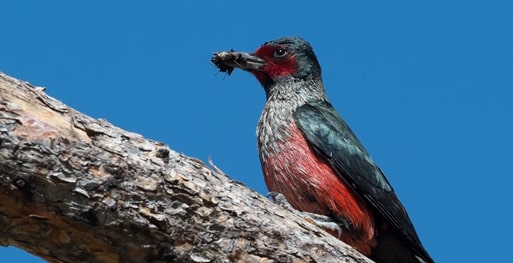
Scientific name: Melanerpes lewis
Size: 10.2-11 inches
Weight: 3.1-4.9 ounces
Wingspan: 19-.20.5 inches
This medium-sized bird lives across the western half of the US, migrating from the northern part of the country to the southern part during the winter. Named for Lewis Merryweather of Lewis and Clark fame, this woodpecker only hangs out in western and southern Montana during the breeding season.
They don’t dig or peck into the wood but find insects crawling around on the bark.
These pretty woodpeckers are green and pink with a red face and white neck, making them stand out among other species. It also likes to catch insects mid-air while flying, which sets it apart from other birds. That’s something most woodpeckers don’t do, for the most part.
As fall comes around, this industrious bird collects acorns and other nuts and stuffs them into cavities in trees so that they have food for later.
Pairs mate for life and make nests in excavated trees or utility poles.
4. Red-headed Woodpecker
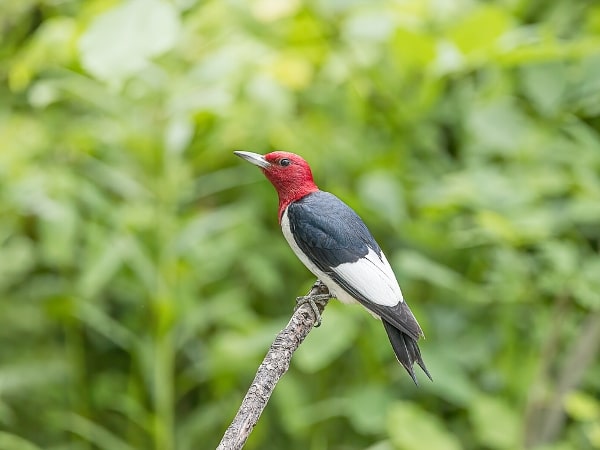
Scientific name: Melanerpes erythrocephalus
Size: 7.5-9.1 inches
Weight: 2.0-3.2 ounces
Wingspan: 16.5 inches
Red-headed woodpeckers are pretty birds. They have solid black wings with a big white patch and white bodies. To top it off, a deep, dark red head and neck that is so vibrant it looks like velvet. The juveniles are brownish-black with white spots on the wings and dull red cheeks.
They don’t usually cross to the west side of the Rocky Mountains, but they can regularly be found in all parts east, from Canada to Florida. You can find them in the eastern parts of Montana during the breeding season.
It’s one of the few woodpeckers out there who like to store food for the winter. They stuff seeds and nuts in bark or holes in trees. They have even been known to stuff food under the roof and wall shingles of homes.
They also hunt their prey, snatching insects out of the air as they fly. That’s uncommon behavior for woodpeckers.
5. Red-Naped Sapsucker
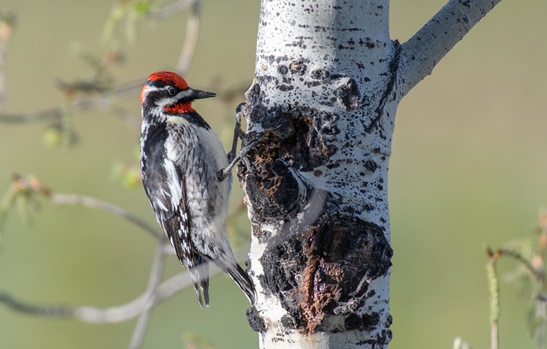
Scientific name: Sphyrapicus nuchalis
Size: 7.5-8.3
Weight: 1.1-2.3 ounces
Wingspan: 16-16.9 inches
As the name suggests, this bird has a thing for the sap in trees. It will tap little holes into the bark so that sugary sap runs out, and it can lap it up with its tiny tongue.
They particularly love aspen, pine, and birch trees. They’ll even nest in backyards that have those trees, so if you have these trees, keep an eye out for this bird. You can even increase the chance that they’ll visit or come to stay if you provide them with a suet feeder.
These sapsuckers have vertical white patches on their back that you can only see when the wing is folded. They have black and white striped bodies and heads and a bright red cap and throat, though some females have a white throat.
This is a close relative of the red-bellied sapsucker and the yellow-bellied sapsucker. They all look fairly similar.
Red-naped sapsuckers can only be found during the summer breeding season in the western half of Montana, so if you’re out birdwatching during the warm months, keep an eye out for them.
6. Northern Flicker
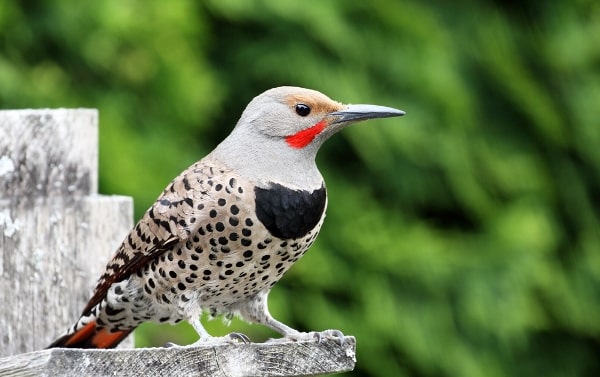
Scientific name: Colaptes auratus
Size: 11-12 inches
Weight: 4-6.5 ounces
Wingspan: 16.5-20 inches
The distinctive Northern Flicker woodpecker lives in open habitats near trees and in parks and cemeteries across Montana. They are a frequent visitor to suet feeders in suburban and urban yards. Unlike some woodpeckers, they like to hunt around on the ground rather than in the trees.
They’re another one of the most common woodpeckers in Montana, but they don’t all look the same, which can make identifying them a challenge.
The males, females, and juveniles vary in appearance depending on where they live. They’re brown in color overall, with black spots. The underside of the wings and tails are yellow in the eastern half of the US and red in the western half of the US.
Some have a red or black stripe on their cheeks, and many of them have large, black crescents on their chest. Others have red marks on the back of the head. Some have a slightly gray head. Confusing, right?
In Montana, these woodpeckers can be identified by their salmon and yellow wings on the undersides.
In the spring, you can hear the calls of Northern flickers for a long way off. They have a distinct call, and once you know how to identify it, it’s easy to tell when they’re nearby.
They primarily eat ants, but they’ll also dine on other insects such as caterpillars, beetles, and termites. They’re definitely a bird you want to have around! There are also instances of them catching young bats as they leave the nest. You can tempt them to visit your home by offering a suet feeder in the yard.
Flickers who live in northern climates like Alaska and Canada will migrate to places with warmer temperatures during the winter. Most stay put in Montana year-round.
Studies show that Northern Flickers can lose their nests to invaders like European starlings. Plus, many humans are trying to deter them because they can make holes in the wood and cavities of homes.
7. American Three-Toed Woodpecker

Scientific name: Picoides dorsalis
Size: 8.3-9.1 inches
Weight: 1.6-2.4 ounces
Wingspan: 14.6-15.3 inches
This woodpecker primarily makes Canada its home, but it also lives year-round in western parts of the country, including Arizona, Montana, Utah, Colorado, and Wyoming. They’re quite uncommon during the winter, but you may see them now and then.
This bird likes to hunt in burned-out areas and forests where beetles have killed lots of trees. It hunts for insects, pulling and stripping away bark until it finds what it is looking for.
Yes, this bird only has three toes, but you’ll most easily be able to identify it by its coloring. It’s primarily black, but it does have white barring on its sides and back, and the chest is white. The male has a bright yellow crown.
If you see these woodpeckers in your Montana yard, welcome them! They eat destructive beetles that can kill trees.
8. Black-Backed Woodpecker
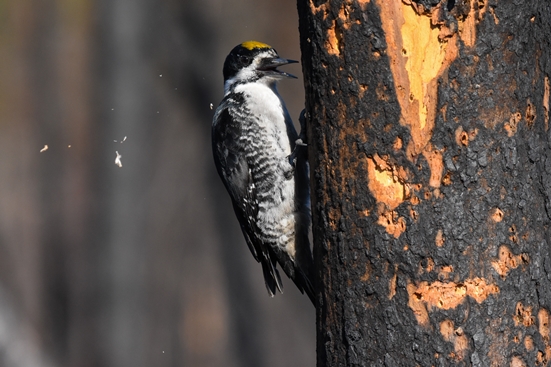
Scientific name: Picoides arcticus
Size: 9.1 inches
Weight: 2.1-3.1 ounces
Wingspan: 15.8-16.5 inches
Many woodpeckers in North America are black and white, often with a red patch on the head. But this woodpecker stands out because of its solid black back and white chest. It has a black face with a distinct white stripe. The male has a small yellow crown.
Making its home in burned-out forests across Canada and the western US, its black coloring helps it blend in with the charred trees that it hunts on. It eats beetle larvae and will hang out in recently-burned areas for several years before moving onto more newly burned areas.
While most of them typically travel to southern areas during the winter, you can see them year-round in the western parts of Montana.
9. Pileated Woodpecker
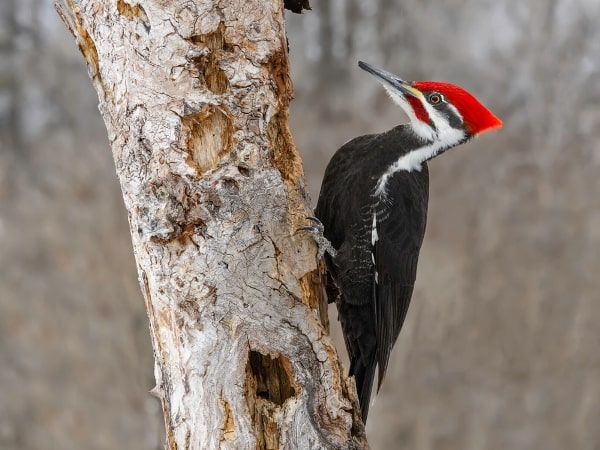
Scientific name: Dryocopus pileatus
Size: 16-19 inches
Weight: 9-14 ounces
Wingspan: 30 inches
The pileated woodpecker only lives in the far western part of Montana in forested areas. They often make their nests in utility poles or high up in tall trees in deadwood. Their favorite snack is carpenter ants, which they will dig rectangular holes deep into the wood to find.
They’ll also eat nuts and berries and have even been known to chomp on poison ivy berries. You may occasionally see them foraging on the ground for food, but they usually stick to the trees.
These striking birds are mostly black and white, but they are very distinct because of their bright red crest. The males also have a red stripe on the side of their faces. These are larger birds, about the same size as a crow.
The pileated woodpecker doesn’t migrate. It stays in the same area year after year. They will, however, move their nest if the eggs fall out of it.
The cartoon bird Woody Woodpecker was likely based on this species. If you look at the comic, you can definitely see the resemblance.
10. Williamson’s Sapsucker
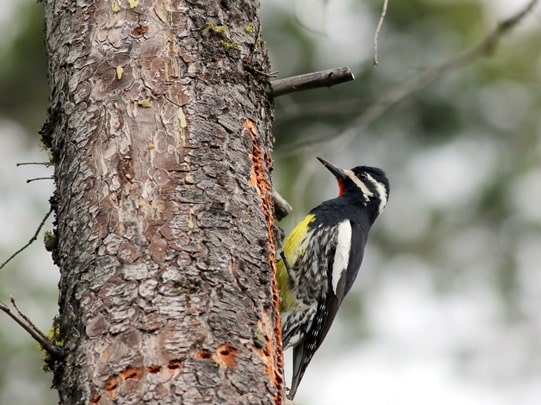
Scientific name: Sphyrapicus thyroideus
Size: 8.3-9.8 inches
Weight: 1.6-1.9 ounces
Wingspan: 17 inches
Like other sapsuckers, this one drills small holes into trees. Then they wait for the sap to start leaking out, and they drink it. They also eat ants and other small insects.
They prefer coniferous forests, and they live in the mountains of western North America. They spend their time in the higher elevation forests and drop down to lower elevations during the winter. In the 1990s, scientists found that this sapsucker had extended its range as far south as Baja California, but they’re more common in states like Montana, where they live in the western part during the breeding season.
Large for a sapsucker, the males are mostly black with white patches on the wings and a red throat. The females have horizontal barring on their backs. They also have brown heads. The sexes appear so different from one another that scientists initially thought that they were separate species.
The males carve out holes in trees to create a nest for the female to lay her eggs in.
Also Read: Owls in Montana
